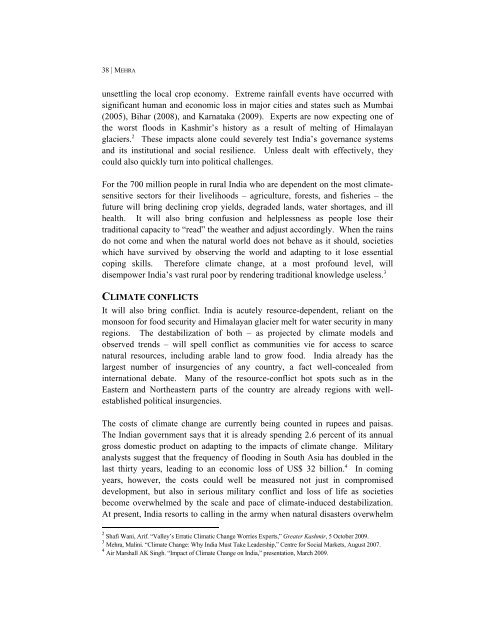Indian Climate Policy - Global Commons Institute
Indian Climate Policy - Global Commons Institute
Indian Climate Policy - Global Commons Institute
You also want an ePaper? Increase the reach of your titles
YUMPU automatically turns print PDFs into web optimized ePapers that Google loves.
38 | MEHRA<br />
unsettling the local crop economy. Extreme rainfall events have occurred with<br />
significant human and economic loss in major cities and states such as Mumbai<br />
(2005), Bihar (2008), and Karnataka (2009). Experts are now expecting one of<br />
the worst floods in Kashmir’s history as a result of melting of Himalayan<br />
glaciers. 2 These impacts alone could severely test India’s governance systems<br />
and its institutional and social resilience. Unless dealt with effectively, they<br />
could also quickly turn into political challenges.<br />
For the 700 million people in rural India who are dependent on the most climatesensitive<br />
sectors for their livelihoods – agriculture, forests, and fisheries – the<br />
future will bring declining crop yields, degraded lands, water shortages, and ill<br />
health. It will also bring confusion and helplessness as people lose their<br />
traditional capacity to “read” the weather and adjust accordingly. When the rains<br />
do not come and when the natural world does not behave as it should, societies<br />
which have survived by observing the world and adapting to it lose essential<br />
coping skills. Therefore climate change, at a most profound level, will<br />
disempower India’s vast rural poor by rendering traditional knowledge useless. 3<br />
CLIMATE CONFLICTS<br />
It will also bring conflict. India is acutely resource-dependent, reliant on the<br />
monsoon for food security and Himalayan glacier melt for water security in many<br />
regions. The destabilization of both – as projected by climate models and<br />
observed trends – will spell conflict as communities vie for access to scarce<br />
natural resources, including arable land to grow food. India already has the<br />
largest number of insurgencies of any country, a fact well-concealed from<br />
international debate. Many of the resource-conflict hot spots such as in the<br />
Eastern and Northeastern parts of the country are already regions with wellestablished<br />
political insurgencies.<br />
The costs of climate change are currently being counted in rupees and paisas.<br />
The <strong>Indian</strong> government says that it is already spending 2.6 percent of its annual<br />
gross domestic product on adapting to the impacts of climate change. Military<br />
analysts suggest that the frequency of flooding in South Asia has doubled in the<br />
last thirty years, leading to an economic loss of US$ 32 billion. 4 In coming<br />
years, however, the costs could well be measured not just in compromised<br />
development, but also in serious military conflict and loss of life as societies<br />
become overwhelmed by the scale and pace of climate-induced destabilization.<br />
At present, India resorts to calling in the army when natural disasters overwhelm<br />
2 Shafi Wani, Arif. “Valley’s Erratic Climatic Change Worries Experts,” Greater Kashmir, 5 October 2009.<br />
3 Mehra, Malini. “<strong>Climate</strong> Change: Why India Must Take Leadership,” Centre for Social Markets, August 2007.<br />
4 Air Marshall AK Singh. “Impact of <strong>Climate</strong> Change on India,” presentation, March 2009.
















